Abstract
On 15-16 September 1997, the U.S. Environmental Protection Agency sponsored the Conference on Preventable Causes of Cancer in Children. The conference was convened to examine rising trends in reported incidence of childhood cancer and the association of these trends with environmental exposures. This paper summarizes recommendations for future research offered by participants. These recommendations included more collaborative research integrating epidemiology, molecular biology, toxicology, and risk assessment; the development of better protocols for toxicologic testing including carcinogenicity using young animals; and research focused on specific periods of development during which susceptibility to environmental agents may be enhanced. Also recommended was enhanced use and development of molecular biomarkers for identification of susceptible populations, and documentation of exposures and effects in epidemiologic and toxicologic studies. Although toxicologic testing is considered essential to determine the effects of potential carcinogens on biological organisms, participants emphasized the need to link these findings with epidemiologic and exposure assessment research.
Full text
PDF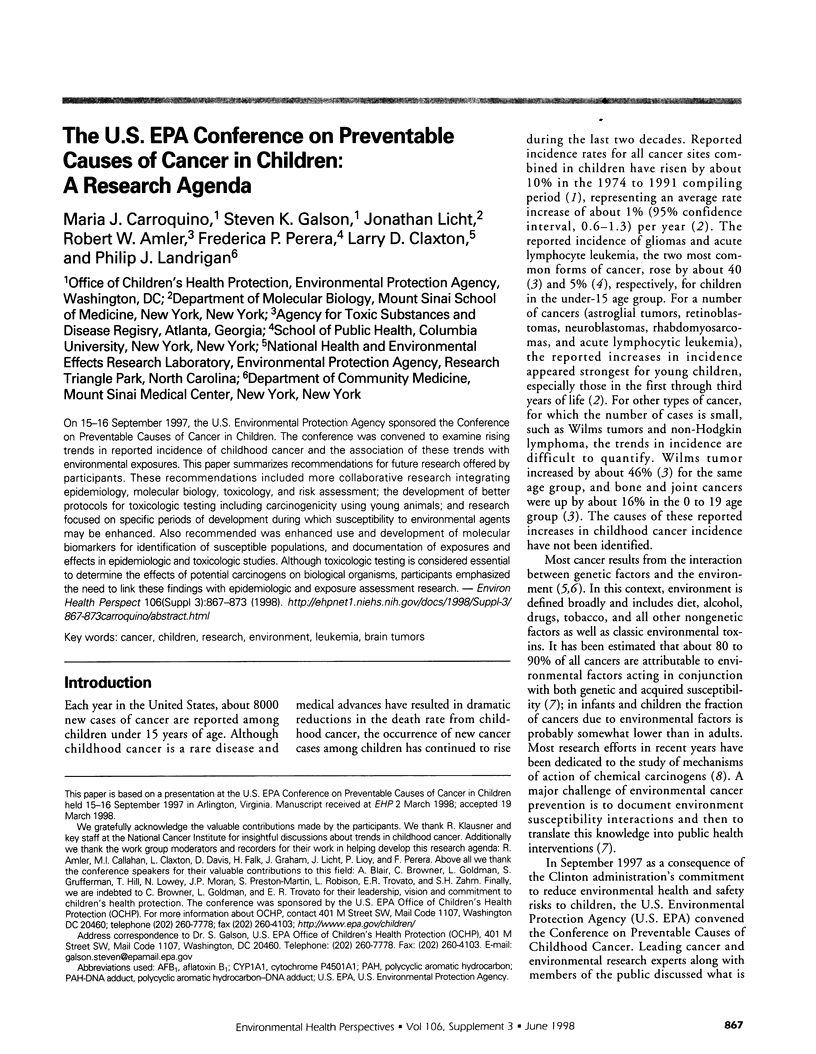
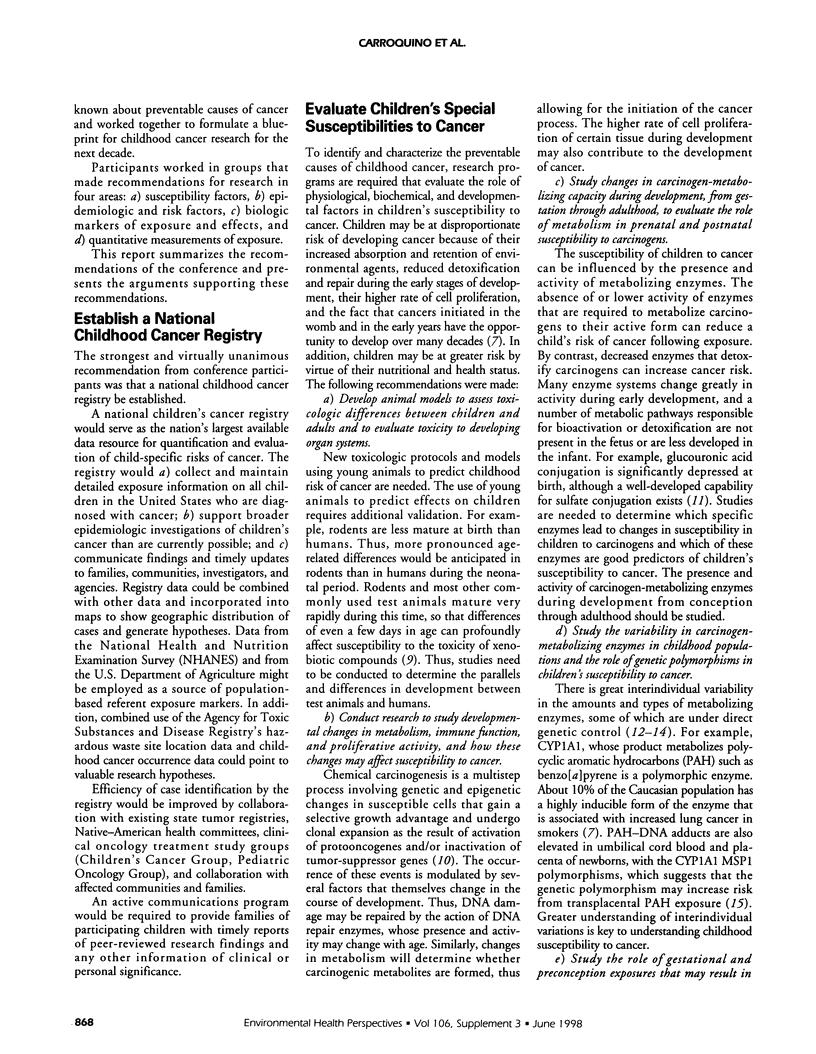
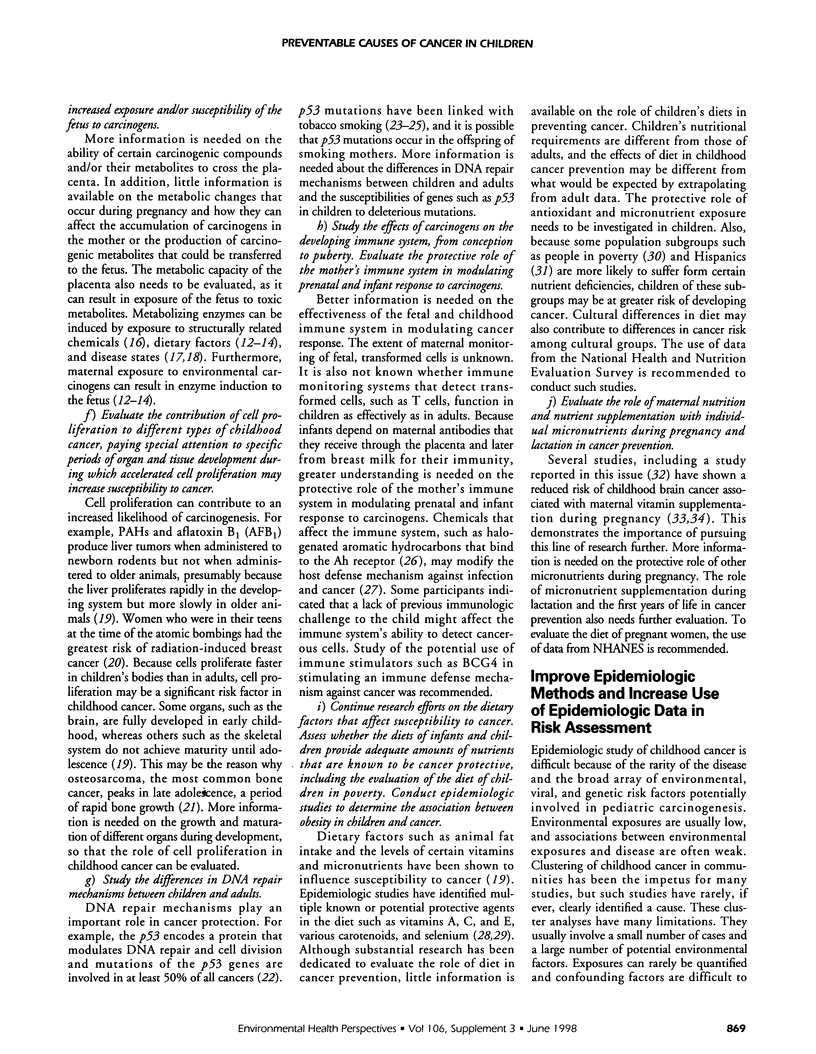
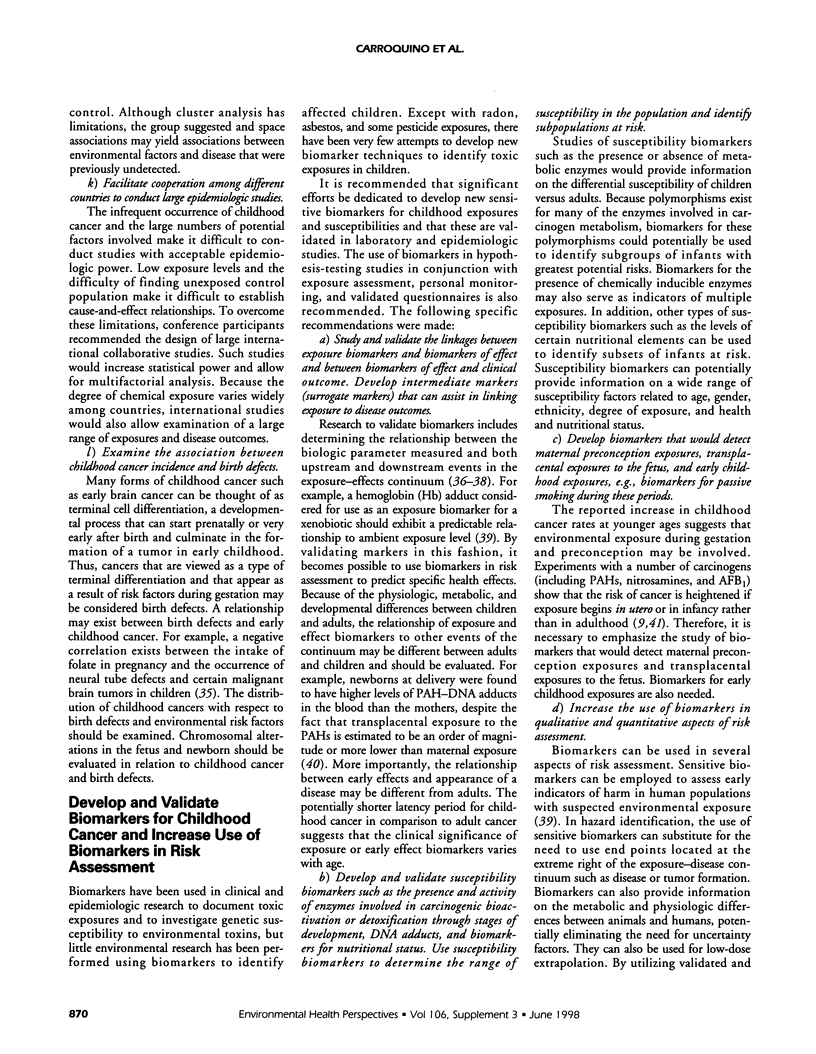
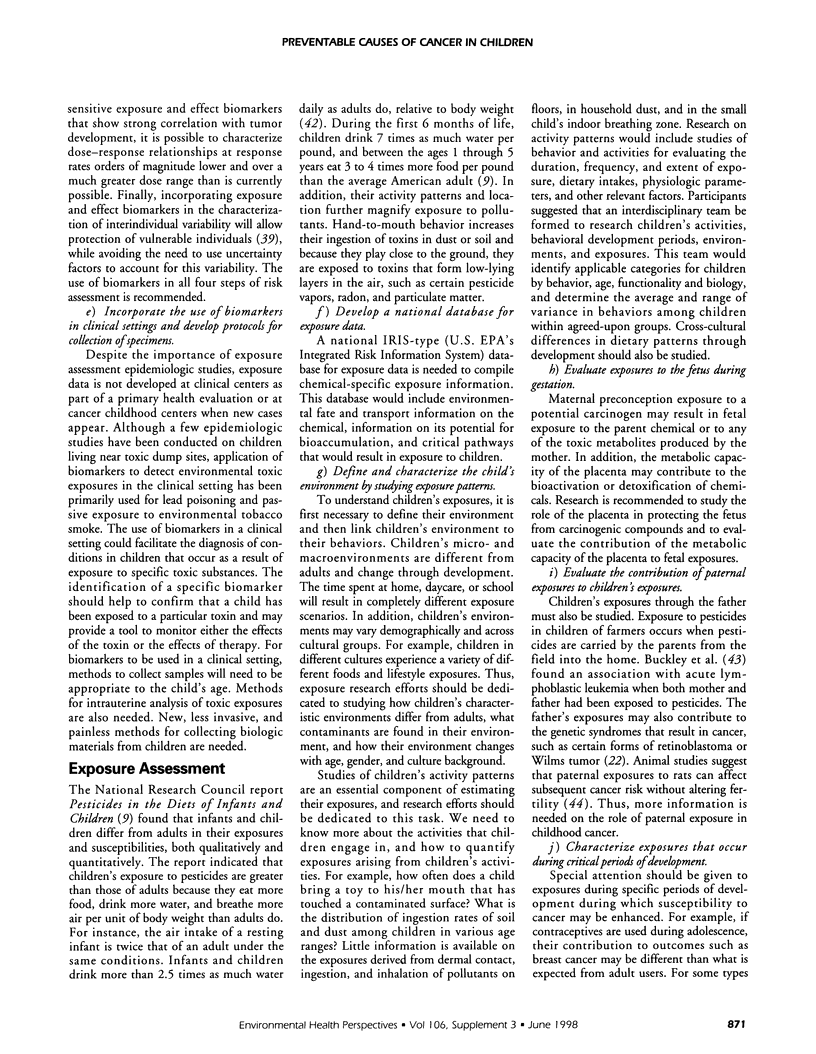
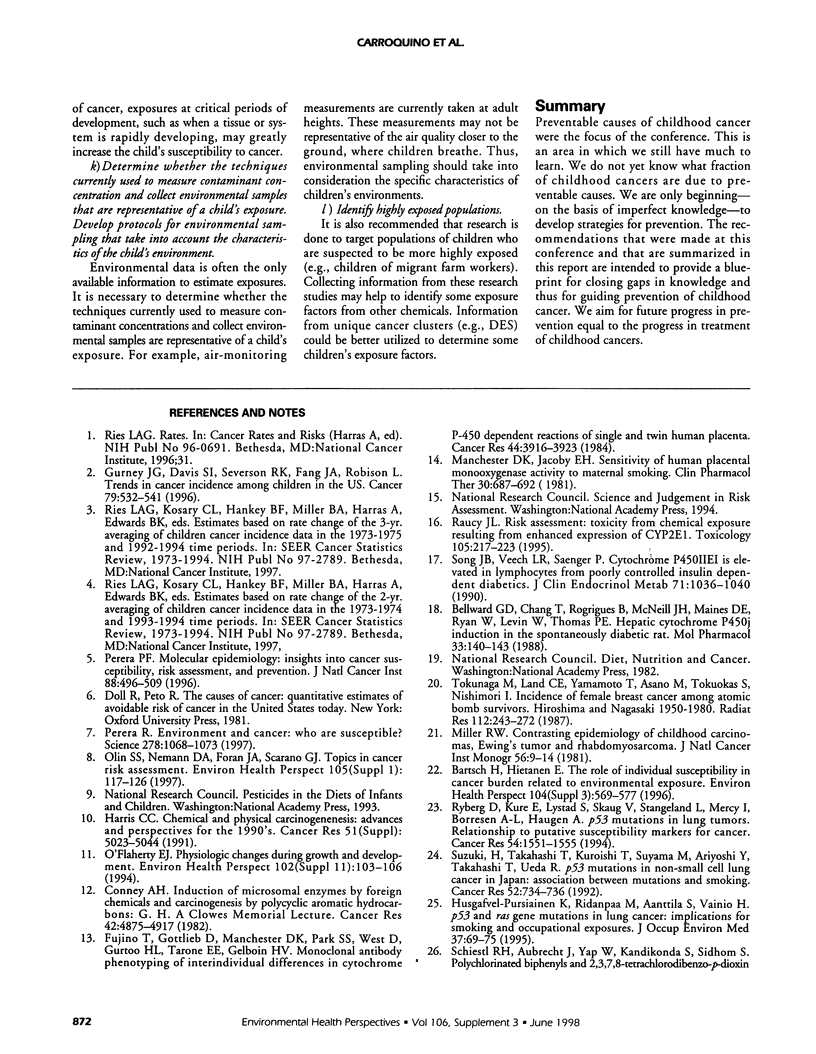
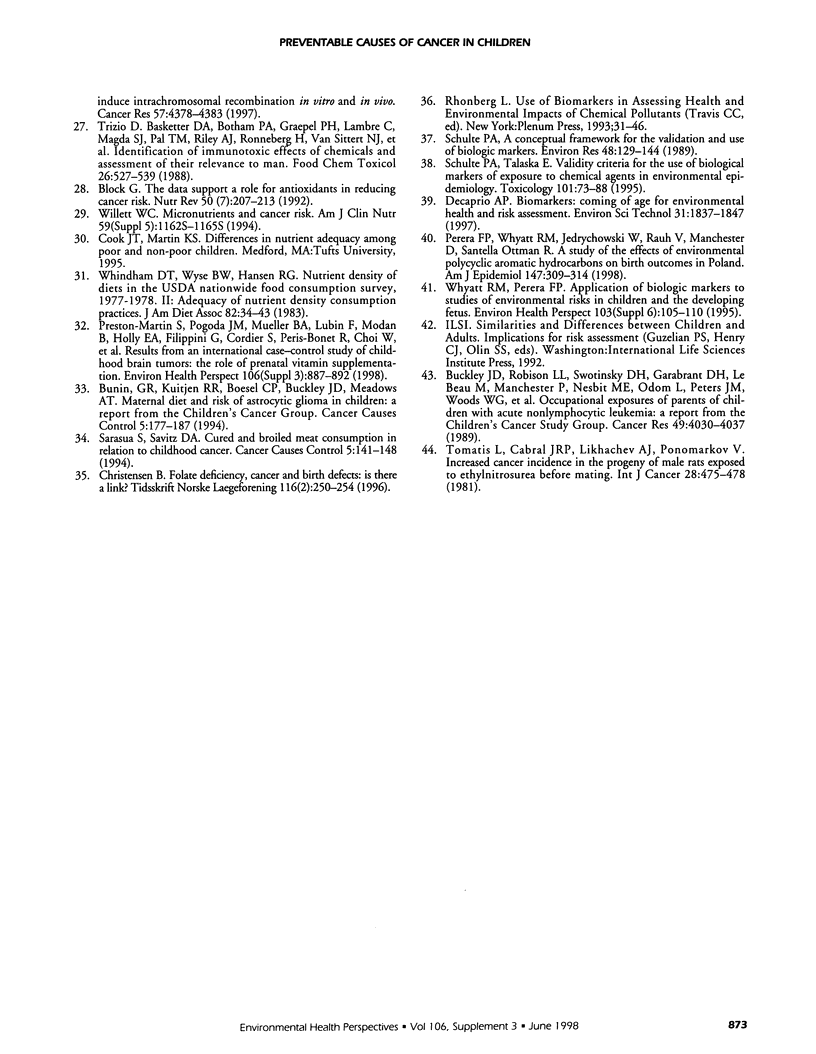
Selected References
These references are in PubMed. This may not be the complete list of references from this article.
- Bartsch H., Hietanen E. The role of individual susceptibility in cancer burden related to environmental exposure. Environ Health Perspect. 1996 May;104 (Suppl 3):569–577. doi: 10.1289/ehp.96104s3569. [DOI] [PMC free article] [PubMed] [Google Scholar]
- Bellward G. D., Chang T., Rodrigues B., McNeill J. H., Maines S., Ryan D. E., Levin W., Thomas P. E. Hepatic cytochrome P-450j induction in the spontaneously diabetic BB rat. Mol Pharmacol. 1988 Feb;33(2):140–143. [PubMed] [Google Scholar]
- Block G. The data support a role for antioxidants in reducing cancer risk. Nutr Rev. 1992 Jul;50(7):207–213. doi: 10.1111/j.1753-4887.1992.tb01329.x. [DOI] [PubMed] [Google Scholar]
- Buckley J. D., Robison L. L., Swotinsky R., Garabrant D. H., LeBeau M., Manchester P., Nesbit M. E., Odom L., Peters J. M., Woods W. G. Occupational exposures of parents of children with acute nonlymphocytic leukemia: a report from the Childrens Cancer Study Group. Cancer Res. 1989 Jul 15;49(14):4030–4037. [PubMed] [Google Scholar]
- Bunin G. R., Kuijten R. R., Boesel C. P., Buckley J. D., Meadows A. T. Maternal diet and risk of astrocytic glioma in children: a report from the Childrens Cancer Group (United States and Canada) Cancer Causes Control. 1994 Mar;5(2):177–187. doi: 10.1007/BF01830264. [DOI] [PubMed] [Google Scholar]
- Conney A. H. Induction of microsomal enzymes by foreign chemicals and carcinogenesis by polycyclic aromatic hydrocarbons: G. H. A. Clowes Memorial Lecture. Cancer Res. 1982 Dec;42(12):4875–4917. [PubMed] [Google Scholar]
- Fujino T., Gottlieb K., Manchester D. K., Park S. S., West D., Gurtoo H. L., Tarone R. E., Gelboin H. V. Monoclonal antibody phenotyping of interindividual differences in cytochrome P-450-dependent reactions of single and twin human placenta. Cancer Res. 1984 Sep;44(9):3916–3923. [PubMed] [Google Scholar]
- Gurney J. G., Davis S., Severson R. K., Fang J. Y., Ross J. A., Robison L. L. Trends in cancer incidence among children in the U.S. Cancer. 1996 Aug 1;78(3):532–541. doi: 10.1002/(SICI)1097-0142(19960801)78:3<532::AID-CNCR22>3.0.CO;2-Z. [DOI] [PubMed] [Google Scholar]
- Manchester D. K., Jacoby E. H. Sensitivity of human placental monooxygenase activity to maternal smoking. Clin Pharmacol Ther. 1981 Nov;30(5):687–692. doi: 10.1038/clpt.1981.221. [DOI] [PubMed] [Google Scholar]
- Miller R. W. Contrasting epidemiology of childhood osteosarcoma, Ewing's tumor, and rhabdomyosarcoma. Natl Cancer Inst Monogr. 1981 Apr;(56):9–15. [PubMed] [Google Scholar]
- O'Flaherty E. J. Physiologic changes during growth and development. Environ Health Perspect. 1994 Dec;102 (Suppl 11):103–106. doi: 10.1289/ehp.94102s11103. [DOI] [PMC free article] [PubMed] [Google Scholar]
- Olin S. S., Neumann D. A., Foran J. A., Scarano G. J. Topics in cancer risk assessment. Environ Health Perspect. 1997 Feb;105 (Suppl 1):117–126. doi: 10.1289/ehp.97105s1117. [DOI] [PMC free article] [PubMed] [Google Scholar]
- Perera F. P. Environment and cancer: who are susceptible? Science. 1997 Nov 7;278(5340):1068–1073. doi: 10.1126/science.278.5340.1068. [DOI] [PubMed] [Google Scholar]
- Perera F. P. Molecular epidemiology: insights into cancer susceptibility, risk assessment, and prevention. J Natl Cancer Inst. 1996 Apr 17;88(8):496–509. doi: 10.1093/jnci/88.8.496. [DOI] [PubMed] [Google Scholar]
- Perera F. P., Whyatt R. M., Jedrychowski W., Rauh V., Manchester D., Santella R. M., Ottman R. Recent developments in molecular epidemiology: A study of the effects of environmental polycyclic aromatic hydrocarbons on birth outcomes in Poland. Am J Epidemiol. 1998 Feb 1;147(3):309–314. doi: 10.1093/oxfordjournals.aje.a009451. [DOI] [PubMed] [Google Scholar]
- Preston-Martin S., Pogoda J. M., Mueller B. A., Lubin F., Modan B., Holly E. A., Filippini G., Cordier S., Peris-Bonet R., Choi W. Results from an international case-control study of childhood brain tumors: the role of prenatal vitamin supplementation. Environ Health Perspect. 1998 Jun;106 (Suppl 3):887–892. doi: 10.1289/ehp.98106887. [DOI] [PMC free article] [PubMed] [Google Scholar]
- Raucy J. L. Risk assessment: toxicity from chemical exposure resulting from enhanced expression of CYP2E1. Toxicology. 1995 Dec 28;105(2-3):217–224. doi: 10.1016/0300-483x(95)03216-3. [DOI] [PubMed] [Google Scholar]
- Ryberg D., Kure E., Lystad S., Skaug V., Stangeland L., Mercy I., Børresen A. L., Haugen A. p53 mutations in lung tumors: relationship to putative susceptibility markers for cancer. Cancer Res. 1994 Mar 15;54(6):1551–1555. [PubMed] [Google Scholar]
- Sarasua S., Savitz D. A. Cured and broiled meat consumption in relation to childhood cancer: Denver, Colorado (United States) Cancer Causes Control. 1994 Mar;5(2):141–148. doi: 10.1007/BF01830260. [DOI] [PubMed] [Google Scholar]
- Schulte P. A. A conceptual framework for the validation and use of biologic markers. Environ Res. 1989 Apr;48(2):129–144. doi: 10.1016/s0013-9351(89)80029-5. [DOI] [PubMed] [Google Scholar]
- Schulte P. A., Talaska G. Validity criteria for the use of biological markers of exposure to chemical agents in environmental epidemiology. Toxicology. 1995 Jul 26;101(1-2):73–88. doi: 10.1016/0300-483x(95)03020-g. [DOI] [PubMed] [Google Scholar]
- Song B. J., Veech R. L., Saenger P. Cytochrome P450IIE1 is elevated in lymphocytes from poorly controlled insulin-dependent diabetics. J Clin Endocrinol Metab. 1990 Oct;71(4):1036–1040. doi: 10.1210/jcem-71-4-1036. [DOI] [PubMed] [Google Scholar]
- Suzuki H., Takahashi T., Kuroishi T., Suyama M., Ariyoshi Y., Takahashi T., Ueda R. p53 mutations in non-small cell lung cancer in Japan: association between mutations and smoking. Cancer Res. 1992 Feb 1;52(3):734–736. [PubMed] [Google Scholar]
- Tokunaga M., Land C. E., Yamamoto T., Asano M., Tokuoka S., Ezaki H., Nishimori I. Incidence of female breast cancer among atomic bomb survivors, Hiroshima and Nagasaki, 1950-1980. Radiat Res. 1987 Nov;112(2):243–272. [PubMed] [Google Scholar]
- Tomatis L., Cabral J. R., Likhachev A. J., Ponomarkov V. Increased cancer incidence in the progeny of male rats exposed to ethylnitrosourea before mating. Int J Cancer. 1981 Oct 15;28(4):475–478. doi: 10.1002/ijc.2910280413. [DOI] [PubMed] [Google Scholar]
- Trizio D., Basketter D. A., Botham P. A., Graepel P. H., Lambré C., Magda S. J., Pal T. M., Riley A. J., Ronneberger H., Van Sittert N. J. Identification of immunotoxic effects of chemicals and assessment of their relevance to man. Food Chem Toxicol. 1988 Jun;26(6):527–539. doi: 10.1016/0278-6915(88)90006-3. [DOI] [PubMed] [Google Scholar]
- Whyatt R. M., Perera F. P. Application of biologic markers to studies of environmental risks in children and the developing fetus. Environ Health Perspect. 1995 Sep;103 (Suppl 6):105–110. doi: 10.1289/ehp.95103s6105. [DOI] [PMC free article] [PubMed] [Google Scholar]
- Willett W. C. Micronutrients and cancer risk. Am J Clin Nutr. 1994 May;59(5 Suppl):1162S–1165S. doi: 10.1093/ajcn/59.5.1162S. [DOI] [PubMed] [Google Scholar]
- Windham C. T., Wyse B. W., Hansen R. G. Nutrient density of diets in the USDA Nationwide Food Consumption Survey, 1977-1978: II. Adequacy of nutrient density consumption practices. J Am Diet Assoc. 1983 Jan;82(1):34–43. [PubMed] [Google Scholar]


